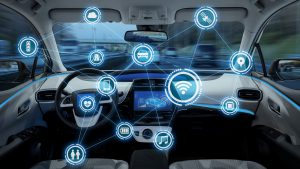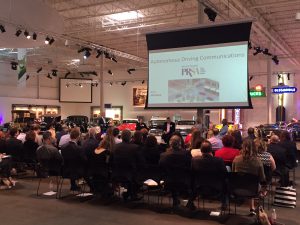880 W. Long Lake Road • Suite 225 •
Troy, Michigan 48098
• P: 248.269.1122 •
E: bianchipr@bianchipr.com
 Autonomous vehicles are coming. We have been hearing it and reading about it for the past few years.
Autonomous vehicles are coming. We have been hearing it and reading about it for the past few years.
The research advisory firm, Gartner, indicated in its 2016 Hype Cycle chart (http://www.gartner.com/newsroom/id/3412017) that driverless cars have moved past the “peak of inflated expectations” and are headed for the so-called “trough of disillusionment”, as it becomes increasingly evident that mass adoption of driverless vehicles will be at least 10 years away and likely more.
In many ways, autonomous vehicles are already here – in bits and pieces, in the new technologies such as lane-keeping, emergency braking, blind-spot detection and other driver-assist systems that are now found on some higher-end vehicles.
And, of course, self-driving technology is already being tested on test tracks and urban streets across the country and around the world, through demonstration vehicles created by the traditional automakers; technology companies such as Waymo, Apple and Uber; and top-tier automotive suppliers such as Delphi, Bosch and ZF.
What’s the hold-up?
Gartner automotive analyst Mike Ramsey says the biggest obstacle to autonomous vehicles becoming mainstream will likely be regulatory: “Governments will need to feel comfortable with the rules put in place before these cars are released to the general public.” (http://www.gartner.com/smarterwithgartner/the-road-to-connected-autonomous-cars/). These complex regulations and the necessary industry standards for autonomy will not be developed or instituted overnight. Politics has its own pace and clock speed.
Earlier this month, Gartner indicated that the full impact of autonomous vehicle technology upon the economy and society would not begin to emerge until approximately 2025, with consumer and social acceptance being a key driver in adoption.
That seems early to me, not because of technical issues, but because of human ones. While Level 5 full autonomous driving is projected to be ready as soon as 2021, actual consumer adoption will take many more years for one simple reason: People are reluctant to change.
Communicating the Benefits of Self-driving Technology
The many companies throughout the emerging autonomous car supply chain who are working on these technologies have a monumental task facing them in the next several years: convincing consumers about the safety and benefits of autonomous vehicles.
Experts agree that the widespread use of autonomous vehicles promises numerous benefits, including: dramatic reduction in accidents and traffic deaths, reduced fuel consumption, reduced highway congestion, improved efficiency, and improved mobility for seniors and the disabled, among others.
With an estimated 93 percent of vehicle accidents caused by human error, the potential for self-driving technology to reduce accidents – and the related fatalities, injuries and costs – alone is huge.
Yet, recent studies show that despite these remarkable potential benefits, most consumers do not yet trust autonomous technology.
Consumers Not Yet Ready to Let Go of the Steering Wheel
A consumer survey conducted by Gartner this spring indicated that 55 percent of people polled in the United States and Germany will not consider riding in a fully autonomous vehicle. (http://www.gartner.com/newsroom/id/3790963). A January 2017 AAA study showed that some three-quarters of respondents said they would not ride in an autonomous car (http://newsroom.aaa.com/2017/03/americans-feel-unsafe-sharing-road-fully-self-driving-cars/).
Jack Weast, senior principal engineer and chief system architect of Intel’s Autonomous Driving Group, recently said, “People are downright scared of robot cars.” (https://www.autoblog.com/2017/08/30/intel-robot-cars-autonomous-driving-study/)
Another study, reported in the Detroit News, indicated that consumer confidence in autonomous technology fell between 2016 and 2017. In that study, 49 percent of pre-Baby Boomers (the Silent generation, born before 1946), 44 percent of baby boomers (born 1946 to 1964) and 34 percent of Gen X (born 1965 to 1976) said they don’t trust autonomous technology http://www.detroitnews.com/story/business/autos/general-motors/2017/04/18/jd-power-consumer-trust-self-driving-tech-drops/100603780/).
Kevin Kelly, Senior Manager – Advanced Technology Communications for General Motors, recently told an audience of automotive PR professional that his number one objective is to build trust in the technology.
That will take time, as these self-driving building blocks are perfected. “We need to get it right before we put it on the road,” Kelly said.
Building Trust in Autonomous Technology
Automakers and self-driving technology suppliers will need to build trust one careful step at a time. Their best bet, according to Kelly, is to concentrate on making the consumer’s first experience with each component of self-driving technology a positive one.
Kelly said in his company’s “endless endeavor to educate consumers,” GM has recognized that the best way to educate consumers about self-driving technologies is to get them into the demo cars and let them experience the technology first-hand.
Other companies are finding the same thing. Intel’s Weast said that when Intel conducted its study of people with no previous experience with autonomous vehicles, it found most said they distrusted the technology. Its Intel Trust Interaction Study actually identified seven key areas of consumer concern with autonomous technology (https://newsroom.intel.com/editorials/when-will-you-be-ready-get-driverless-car/).
But, when Intel concluded that study by offering respondents an actual test ride in an autonomous vehicle, it found that: “Every single participant experienced a huge leap in their confidence level after their journey.”
Ride-sharing companies such as Uber and Lyft are leading the way in the testing of autonomous vehicle technologies. Beyond helping to perfect the technologies, these ride-sharing services are expected to be a key factor in building consumer trust in the technology, as autonomous ride-sharing vehicles will enable consumers a no-risk opportunity to try the technology before they consider buying it.
 Ramifications for Communicators
Ramifications for Communicators
So what are the ramifications for automotive public relations and communications professionals around all this?
Automakers will want to build trust among consumers and influencers in their autonomous systems … and demonstrate the many benefits in terms of safety, convenience, efficiency and environment … without creating empty hype of damaging long-term corporate reputation.
Automotive retailers will need to play an important role in exposing consumers to the new technologies and to helping educate and train them in the use of such technologies. Dealer-hosted technology events, video tutorials and hands-on simulators will help this education process.
Challenges for Traditional Auto Suppliers
Suppliers of advanced driver assistance systems (ADAS), the building blocks for autonomous driving, face a difficult challenge. Autonomous driving, as well as the electrification of powertrains, the emergence of shared mobility and the move toward connected cars, are causing huge disruption in the traditional automotive OEM supply chain.
Amidst this automotive disruption, many of traditional suppliers will be gone, and many new players will emerge. Suppliers need to communicate their strategy to adapt to and thrive in the new environment not only to media, customers and investors, but also to their own employees and the needed tech talent they want to attract.
Suppliers are recognizing that they cannot do it all alone, which may be new territory for many of them. They must demonstrate the new capabilities they have developed or acquired … and overcome pigeonholing by long-time automaker customers who may still think of them in old ways.
Part of this communication with be telling the stories of not only the new technologies, but just as importantly, the stories of their new acquisitions, partnerships and capabilities. Not just to the automakers, but to the world.
Suppliers can effectively tell these stories by:
To attract the right talent they need to their autonomous future a reality, suppliers need to show their current and future workforce how they can contribute to make the world cleaner, safer and better.
ADAS suppliers must help to promote and differentiate their systems to automakers, attract the new technology partners and engineering talent they need to help them make these systems work, and convince their stakeholders of the soundness of their strategy and plan forward … all without crossing the line into hype.
Challenges for New Automotive Technology Suppliers & Start-ups
The mega trends of autonomous driving, e-mobility, connected cars and ride-sharing/car-sharing are reinventing the automotive ecosystem … and creating huge opportunity for new players whose software or technology will enable the auto’s evolution.
The challenge for many of these technology companies and start-ups is that there is so much competition and so much hype, that it’s difficult for a new player to get through to the very companies they can help the most – the top tier automotive suppliers and automakers.
Emerging from a different industry with a different mindset, language and clock speed, these tech companies may not have a good handle on the peculiarities of the automotive OEM market, the rules of engagement and the development process.
So their challenge is to not only to demonstrate the viability of their technology, but also prove how they can add value as a development partner, how they can work successfully with the automaker or top tier supplier. Just building a better mousetrap will not guarantee their success in the automotive OEM space.
Ultimately, the move toward autonomous driving is changing everything – from the way cars are operated to the way the supply chain is organized. It will create opportunities for some companies, and cause the demise of others. It is rewriting the playbooks of both the auto industry and the tech sector … and it is building a bridge between the old auto industry and Silicon Valley, in hopes of connecting the best of both to create a better world.